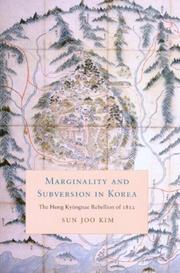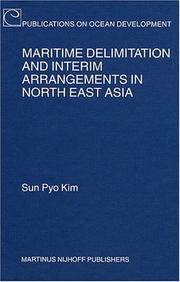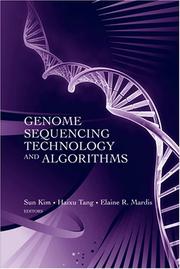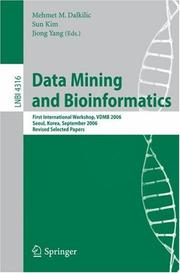| Listing 1 - 10 of 14 | << page >> |
Sort by
|
Book
ISBN: 1536178381 Year: 2020 Publisher: New York : Nova Science Publishers,
Abstract | Keywords | Export | Availability | Bookmark
 Loading...
Loading...Choose an application
- Reference Manager
- EndNote
- RefWorks (Direct export to RefWorks)

ISBN: 9780295986845 0295986840 9780295989310 0295989319 029580338X 9780295803388 Year: 2007 Publisher: Seattle University of Washington Press
Abstract | Keywords | Export | Availability | Bookmark
 Loading...
Loading...Choose an application
- Reference Manager
- EndNote
- RefWorks (Direct export to RefWorks)
Hong Kyong-nae Incident, 1811-1812 --- Korea --- History --- K9155 --- K9300.50 --- K9309 --- Korea: History -- late Chosŏn period, isolation, Qing dependency (1600-1895), Manchu invasions (1627, 1637) --- Korea: Social sciences -- social and cultural history -- Chosŏn period (1392-1910) --- Korea: Social sciences, society -- social theory, movements and protests --- Hong Kyŏng-nae Incident, 1811-1812 --- Korea - History - 1637-1864 --- Hong Kyŏng-nae Incident, 1811-1812.

ISBN: 900413669X 9786610914838 9047404807 1280914831 1429414804 9781429414807 9789004136694 Year: 2004 Publisher: The Hague ; New York : M. Nijhoff,
Abstract | Keywords | Export | Availability | Bookmark
 Loading...
Loading...Choose an application
- Reference Manager
- EndNote
- RefWorks (Direct export to RefWorks)
This work will be a useful guide for those who look for rules and practice on the relations between neighboring States in the absence of maritime boundaries. The main question the author is trying to tackle is how to handle the relations between neighboring coastal States when there is no maritime boundary in place. This book attempts to clarify the legal issues of exploitation of oil, gas and fisheries resources, and jurisdictional conflicts with regard to marine scientific research and protection of the marine environment in disputed areas. This book shows numerous instances of provisional arrangements in disputed areas around the globe together with as many as forty-five valuable maps. The author, a scholar and diplomat of Korea, gives an up-to-date and in-depth analysis of the complicated legal issues of maritime delimitation and provisional arrangements in North East Asia. The English texts of the provisional arrangements in the region annexed to the book are also valuable materials.
Territorial waters --- Economic zones (Law of the sea) --- Continental shelf --- Continental margins --- Economic zones (Maritime law) --- Exclusive economic zones (Law of the sea) --- Patrimonial sea (Law of the sea) --- Law of the sea --- Contiguous zones (Law of the sea) --- Limit, Three-mile (Territorial waters) --- Marginal sea (Territorial waters) --- Maritime belt (Territorial waters) --- Territorial sea --- Three-mile limit (Territorial waters) --- Bodies of water --- Jurisdiction, Territorial --- Territory, National --- Innocent passage (Law of the sea)
Book
ISBN: 0295802170 9780295802176 0295990414 9780295990415 Year: 2010 Publisher: Seattle Center for Korea Studies, University of Washington University of Washington Press
Abstract | Keywords | Export | Availability | Bookmark
 Loading...
Loading...Choose an application
- Reference Manager
- EndNote
- RefWorks (Direct export to RefWorks)
Ethnicity --- Regionalism --- Ethnic identity --- Group identity --- Cultural fusion --- Multiculturalism --- Cultural pluralism --- Human geography --- Nationalism --- Interregionalism --- P'yŏngan-bukto (Korea) --- Hamgyŏng-bukto (Korea) --- Hwanghae-bukto (Korea) --- Hwanghae-pukto (Korea) --- Hwanghae-do (Korea) --- Hamgyŏng-pukto (Korea) --- Kankyŏ Hokudō (Korea) --- North Hamgyŏng Province (Korea) --- Hamgyŏng-pukto --- Pʻyŏngan-pukto (Korea) --- Heian Hokudō (Korea) --- Chagang-do (Korea) --- Pʻyŏngan-do (Korea) --- History. --- K9250 --- K9335.50 --- Korea: Geography and local history -- North Korea --- Korea: Communities, social classes and groups -- North Korea
Book
ISBN: 0804786658 9780804786652 0804783810 9780804783811 Year: 2013 Publisher: Stanford, CA Stanford University Press
Abstract | Keywords | Export | Availability | Bookmark
 Loading...
Loading...Choose an application
- Reference Manager
- EndNote
- RefWorks (Direct export to RefWorks)
Kim resurrects the forgotten historical memory of people, family, lineage, and region, while at the same time enriching the social history of late Choson Korea, by examining the life and work of Yi Sihang, a historically obscure person from a hinterland in the northwestern region, but an advocate of the history and culture of the region he came from and a literatus whose literary talent was recognised by his contemporaries.
Elite (Social sciences) --- Central-local government relations --- Center-periphery government relations --- Local-central government relations --- Local government-central government relations --- Political science --- Decentralization in government --- Federal government --- Elites (Social sciences) --- Leadership --- Power (Social sciences) --- Social classes --- Social groups --- History --- Yi, Sihang, --- P'yongan-do (Korea) --- Korea --- P'yŏngan-namdo (Korea) --- P'yŏngan-bukto (Korea) --- Historiography.
Book
ISBN: 3662471817 3662471809 Year: 2017 Publisher: Berlin, Heidelberg : Springer Berlin Heidelberg : Imprint: Springer,
Abstract | Keywords | Export | Availability | Bookmark
 Loading...
Loading...Choose an application
- Reference Manager
- EndNote
- RefWorks (Direct export to RefWorks)
This book provides state of the art knowledge on a broad range of clinical issues in pancreatic cancer, covering topics from screening and pathophysiology to surgical treatments. In particular, the focus is on current controversies and on evidence-based surgical techniques. Further aspects considered include the management of precancerous lesions, diagnostic methods, perioperative care and nonsurgical treatment. The description of surgical methods is supported by many helpful illustrations and important technical issues are carefully addressed. Determination of resectability and extent of surgery is also discussed. Based on recent developments in surgical techniques, some surgeons are performing more and more radical operations. It is essential, however, that surgical strategy is based on the best available evidence and surgeons will find that this book offers valuable help in achieving this aim. In addition, it will be a great asset in clinical practice for all who are involved or interested in the management of pancreatic cancer.
Medicine. --- Radiology. --- Pathology. --- Surgery. --- Medicine & Public Health. --- Diagnostic Radiology. --- Pancreas --- Cancer. --- Cancer --- Radiology, Medical. --- Disease (Pathology) --- Medical sciences --- Diseases --- Medicine --- Medicine, Preventive --- Surgery, Primitive --- Clinical radiology --- Radiology, Medical --- Radiology (Medicine) --- Medical physics --- Radiological physics --- Physics --- Radiation
Book
Abstract | Keywords | Export | Availability | Bookmark
 Loading...
Loading...Choose an application
- Reference Manager
- EndNote
- RefWorks (Direct export to RefWorks)
"This collection presents and analyzes inquest records that tell the stories of ordinary Korean people under the Chosŏn court (1392-1910). Extending the study of this period, usually limited to elites, into the realm of everyday life, each inquest record includes a detailed postmortem examination and features testimony from everyone directly or indirectly related to the incident. The result is an amazingly vivid, colloquial account of the vibrant, multifaceted societal and legal cultures of early modern Korea. Sun Joo Kim is the Harvard-Yenching Professor of Korean History at Harvard University. Jungwon Kim is assistant professor of Korean history at Columbia University; 'This book provides an extremely rare view into social interactions among people of quite different classes in Chosŏn Korea. Points of interest abound'--Robert E. Hegel, Washington University, St. Louis; 'This is an important contribution that significantly advances our knowledge of nineteenth-century Korean legal history. The translated cases shine by being able to introduce daily struggles of non-elites and illustrate the complex dynamics of the judiciary system during the last century of the Chosŏn dynasty'--Jisoo Kim, George Washington University"--
Wrongful death --- Court records --- Courts --- Law --- Social classes --- History --- History --- Social aspects --- History --- History --- Korea --- Korea --- History --- Social conditions

ISBN: 1596930950 9781596930957 1596930942 9781596930940 Year: 2008 Publisher: Boston : Artech House,
Abstract | Keywords | Export | Availability | Bookmark
 Loading...
Loading...Choose an application
- Reference Manager
- EndNote
- RefWorks (Direct export to RefWorks)
"From a who's who of pioneers in the field comes a unique resource covering the latest advances in next generation genome sequencing and assembly. This groundbreaking book includes non-conventional techniques that are paving the way to potential new biomedical applications. Practitioners find unparalleled access to state-of-the-art DNA sequencing technologies, new algorithmic sequence assembly techniques, and emerging methods for both resequencing and de novo genome analysis, which all together offer the most solid foundation possible for tackling the full range of experimental and computational challenges in the genome sciences today."--Jacket.
Genomes --- Nucleotide sequence. --- Analysis, Nucleic acid sequence --- Analysis, Nucleotide sequence --- Base sequence (Nucleic acids) --- DNA sequence --- Nucleic acid sequence analysis --- Nucleotide sequence analysis --- RNA sequence --- Sequence, Nucleotide --- Nucleic acids --- Nucleotides --- Sequence alignment (Bioinformatics) --- Genetics --- Genomics --- Haploidy --- Analysis. --- Analysis

ISBN: 9783540689706 3540689702 3540689710 Year: 2006 Publisher: Berlin ; New York : Springer,
Abstract | Keywords | Export | Availability | Bookmark
 Loading...
Loading...Choose an application
- Reference Manager
- EndNote
- RefWorks (Direct export to RefWorks)
This volume contains the papers presented at the inaugural workshop on Data Mining and Bioinformatics at the 32nd International Conference on Very Large Data Bases (VLDB). The purpose of this workshop was to begin bringing - gether researchersfrom database, data mining, and bioinformatics areas to help leverage respective successes in each to the others. We also hope to expose the richness, complexity, and challenges in this area that involves mining very large complex biological data that will only grow in size and complexity as geno- scale high-throughput techniques become more routine. The problems are s- ?ciently di?erent enough from traditional data mining problems (outside of life sciences) that novel approaches must be taken to data mine in this area. The workshop was held in Seoul, Korea, on September 11, 2006. We received 30 submissions in response to the call for papers. Each subm- sion was assigned to at least three members of the Program Committee. The Program Committee discussed the submission electronically, judging them on their importance, originality, clarity, relevance, and appropriateness to the - pected audience. The Program Committee selected 15 papers for presentation. These papers arein the areasof microarraydata analysis, bioinformaticssystem and text retrieval, application of gene expression data, and sequence analysis. Because of the format of the workshop and the high number of submissions, many good papers could not be included.
Bioinformatics --- Data mining --- Bio-informatique --- Exploration de données (Informatique) --- Congresses. --- Congrès --- Databases, Genetic --- Computational Biology --- Information Storage and Retrieval --- Biology --- Medical Informatics Applications --- Databases, Factual --- Information Science --- Databases as Topic --- Biological Science Disciplines --- Medical Informatics --- Natural Science Disciplines --- Information Systems --- Disciplines and Occupations --- Computer Science --- Biology - General --- Engineering & Applied Sciences --- Health & Biological Sciences --- Computer science. --- Health informatics. --- Mathematical statistics. --- Data mining. --- Information storage and retrieval. --- Artificial intelligence. --- Bioinformatics. --- Computer Science. --- Artificial Intelligence (incl. Robotics). --- Data Mining and Knowledge Discovery. --- Information Storage and Retrieval. --- Computational Biology/Bioinformatics. --- Probability and Statistics in Computer Science. --- Health Informatics. --- Bio-informatics --- Biological informatics --- Information science --- Computational biology --- Systems biology --- AI (Artificial intelligence) --- Artificial thinking --- Electronic brains --- Intellectronics --- Intelligence, Artificial --- Intelligent machines --- Machine intelligence --- Thinking, Artificial --- Bionics --- Cognitive science --- Digital computer simulation --- Electronic data processing --- Logic machines --- Machine theory --- Self-organizing systems --- Simulation methods --- Fifth generation computers --- Neural computers --- Algorithmic knowledge discovery --- Factual data analysis --- KDD (Information retrieval) --- Knowledge discovery in data --- Knowledge discovery in databases --- Mining, Data --- Database searching --- Mathematics --- Statistical inference --- Statistics, Mathematical --- Statistics --- Probabilities --- Sampling (Statistics) --- Clinical informatics --- Health informatics --- Medical information science --- Medicine --- Informatics --- Science --- Data processing --- Statistical methods --- Information storage and retrieva. --- Medical records --- Artificial Intelligence. --- Data processing. --- EHR systems --- EHR technology --- EHRs (Electronic health records) --- Electronic health records --- Electronic medical records --- EMR systems --- EMRs (Electronic medical records) --- Information storage and retrieval systems --- Medical care --- Information storage and retrieval systems. --- Automatic data storage --- Automatic information retrieval --- Automation in documentation --- Computer-based information systems --- Data processing systems --- Data storage and retrieval systems --- Discovery systems, Information --- Information discovery systems --- Information processing systems --- Information retrieval systems --- Machine data storage and retrieval --- Mechanized information storage and retrieval systems --- Computer systems --- Electronic information resources --- Data libraries --- Digital libraries --- Information organization --- Information retrieval
Book
Year: 2021 Publisher: Basel, Switzerland MDPI - Multidisciplinary Digital Publishing Institute
Abstract | Keywords | Export | Availability | Bookmark
 Loading...
Loading...Choose an application
- Reference Manager
- EndNote
- RefWorks (Direct export to RefWorks)
Sensor technology for monitoring vital signs is an important topic for various service applications, such as entertainment and personalization platforms and Internet of Things (IoT) systems, as well as traditional medical purposes, such as disease indication judgments and predictions. Vital signs for monitoring include respiration and heart rates, body temperature, blood pressure, oxygen saturation, electrocardiogram, blood glucose concentration, brain waves, etc. Gait and walking length can also be regarded as vital signs because they can indirectly indicate human activity and status. Sensing technologies include contact sensors such as electrocardiogram (ECG), electroencephalogram (EEG), photoplethysmogram (PPG), non-contact sensors such as ballistocardiography (BCG), and invasive/non-invasive sensors for diagnoses of variations in blood characteristics or body fluids. Radar, vision, and infrared sensors can also be useful technologies for detecting vital signs from the movement of humans or organs. Signal processing, extraction, and analysis techniques are important in industrial applications along with hardware implementation techniques. Battery management and wireless power transmission technologies, the design and optimization of low-power circuits, and systems for continuous monitoring and data collection/transmission should also be considered with sensor technologies. In addition, machine-learning-based diagnostic technology can be used for extracting meaningful information from continuous monitoring data.
cardiopulmonary resuscitation (CPR) --- electroencephalogram (EEG) --- hemodynamic data --- carotid blood flow (CBF) --- cerebral circulation --- frequency-shift keying radar --- cross-correlation --- envelope detection --- continuous-wave radar --- frequency discrimination --- vital-signs monitoring --- heartbeat accuracy improvement --- heartbeat detection --- absolute distance measurement --- radar signal processing --- 3D+t modeling --- coronary artery --- non-rigid registration --- cage deformation --- 4D CT --- passenger detection --- CW radar --- radar feature vector --- radar machine learning --- wearable sensors --- physiology --- medical monitoring --- vital signs --- compensatory reserve --- ultra-high resolution --- cone-beam computed tomography --- low-contrast object --- optimal filter --- modulation transfer function --- noise power spectrum --- doppler cardiogram --- wavelet transform --- denoising --- mother wavelet function --- decomposition level --- signal decomposition --- signal-to-noise-ratio
| Listing 1 - 10 of 14 | << page >> |
Sort by
|

 Search
Search Feedback
Feedback About UniCat
About UniCat  Help
Help News
News